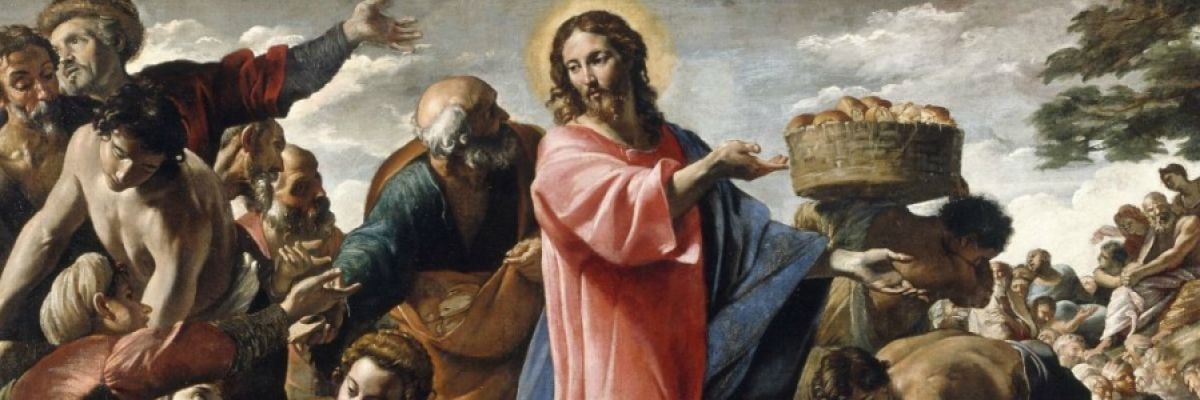
Homily for the Eighteenth Sunday in Ordinary Time, Year B
They said to him,
“What sign can you do, that we may see and believe in you?
What can you do?
Our ancestors ate manna in the desert, as it is written:
He gave them bread from heaven to eat.”
So Jesus said to them,
“Amen, amen, I say to you,
it was not Moses who gave the bread from heaven;
my Father gives you the true bread from heaven.
For the bread of God is that which comes down from heaven
and gives life to the world.”-John 6:30-33
Why would the Savior have worked such a miracle as the feeding of the 5,000? Considering the size of the crowd, which according to scholars was the majority of the Jewish population of Galilee at the time, and assuming that he was simply seeking to make them his followers like a politician, one could suspect his motives.
This was the evaluation of Our Lord’s enemies: they imagined that he wanted to be an earthly king, to win the people over to his rule.
But the Lord clearly rejected an earthly interpretation of his miraculous gesture. The people may have been interested in following after him because he could provide the means of life without work or effort, like a socialist demagogue would promise, but he had something else in mind.
Our Lord works miracles precisely so that people might be drawn beyond the evidence of their senses to believe in things that cannot be sensed or known by the evidence of sight or touch or taste. A miracle causes wonder, which means that those who witness it cannot explain its cause by the usual empirical or scientific means. It is evidence for something that has to be accepted without seeing.
To be sure, the miracle is an evident, sensible fact; but its cause, the power that brought it about, cannot be found out by our senses. A miracle is beyond any created power and so cannot be explained by any mechanism or art proportionate to human knowing.
In the case of today’s Gospel lesson it is clear, and will be more so in the coming weeks as we follow the sixth chapter of St. John’s Gospel, that the Savior is showing the people a miracle that their senses perceive so that they can be disposed to believe in something more than a miracle, something that can never be perceived by the senses: the mystery-beyond-a-miracle of the Holy Eucharist.
St. Thomas tells us that not even the human powers of Christ can “see” himself in the Eucharist. The Eucharist is a reality only perceptible to the mind, whether by faith or by vision in heaven, and it can only be taken in by us by a loving will if we are disposed to offer, adore, and receive it.
In what does this mystery consist? Well, there are many aspects to it, but let us say, focusing on the reality of Our Lord’s bodily, substantial presence, what the mystery entails in its most basic aspect. Our faith in the “real presence” amounts to this: that we believe, but do not see (if we are still in this life) or that we see, but not with bodily eyes (if we are already in heaven) that the natural body of Christ, as it is extended and locally present in heaven (what this means is for another homily) bears such a relation to the mere appearances of bread and wine that after the consecration of the Mass, wherever these appearances are, he is present substantially and really with his body and blood (and therefore also with, his soul and his godhead).
What our mind cannot take in is precisely what this relation is. We know of many things that appear before us here and now in their effects, but are actually a long way away. Modern communications technology has shown us this. We know what constitutes those relationships on account of our technological knowledge; but in the case of the Blessed Sacrament the body and blood of the Lord are as truly present by this mysterious relationship as they are in heaven.
Human reason simply cannot penetrate this mystery, and so it has to be believed. It is the “mystery of faith” par excellence. It is the most perfect of signs: visible, but so purely a sign that it contains what it means.
So there is almost a certain irony in the people asking Christ what kind of sign he could show them. They were looking for an imperfect sign, a proof of something for the senses. He gave them the challenge of one miracle to lead them to believe without relying on their senses at all.
Someday in heaven we will, by God’s grace and mercy, perceive in the light of his face how this real relationship between the natural body of the Lord and the species of bread, and the natural blood of the Lord and the species of wine, is possible. This will be the ultimate feeding on this mystery: the fulfillment of all our hopeful worship of the Holy Eucharist here below!



